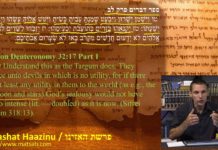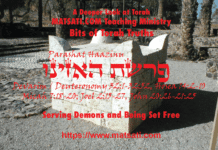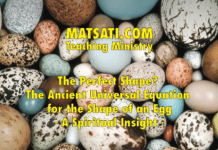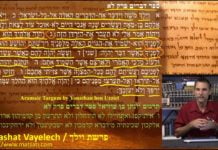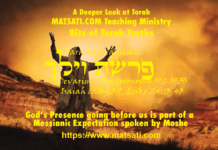This weeks reading is from Parashat Chukat (Bamidbar / Numbers 16:1-18:32), the priest takes the “red heifer” outside of the camp, slaughters the heifer, and sprinkles the blood towards the front of the Tent of Meeting seven times. The entire heifer is burned to ashes, its hide, flesh, blood, refuse (19:5) and cedar wood, hyssop, and scarlet material are cast into the midst of the burning heifer. A ritually pure man is to gather up the ashes of the heifer. The ashes mixed with water are used for the removal of impurity (19:8-9). Next, the mitzvot on touching the dead; if one is in the room with a dead person, he is unclean; if a one touches a dead man he is unclean. In addition to this, if one who is unclean by the dead comes in physical contact with someone else, that person also becomes ritually impure (19:22). These Scriptures reveal to us that impurity behaves as a transmittable disease. In addition to this, it is interesting to note that death is connected to ritual purity and right standing with God (i.e. the ashes of the red heifer). The scriptures state that Miriam died and was buried in the wilderness of Zin (20:1). The people arrived at Kadesh in the wilderness of Zin; there is no water and the people complain. The Lord instructs Moshe to take Aaron’s staff and to “speak to the rock in their eyes.” Moshe and Aaron take the staff, go before the people, they speak harshly to the people and strike the rock two times (20:25-29). The people complain because of the long journey and the Lord sends fiery serpents among the people and many die (21:6). Moshe sets up a bronze serpent, everyone who looks upon the serpent did not die if they had been bitten. Israel moved from place to place and we read that Sihon refused to allow Israel to pass and so Israel struck him by the edge of the sword and took possession of the land from Armon to the Jabbok as far as the sons of Ammon (21:23-24).
כתבי הקודש / The Holy Scriptures
ספר במדבר פרק כא
ה וַיְדַבֵּר הָעָם בֵּאלֹהִים וּבְמֹשֶׁה לָמָה הֶעֱלִיתֻנוּ מִמִּצְרַיִם לָמוּת בַּמִּדְבָּר כִּי אֵין לֶחֶם וְאֵין מַיִם וְנַפְשֵׁנוּ קָצָה בַּלֶּחֶם הַקְּלֹקֵל: ו וַיְשַׁלַּח יְהוָֹה בָּעָם אֵת הַנְּחָשִׁים הַשְּׂרָפִים וַיְנַשְּׁכוּ אֶת-הָעָם וַיָּמָת עַם-רָב מִיִּשְֹרָאֵל: ז וַיָּבֹא הָעָם אֶל-מֹשֶׁה וַיֹּאמְרוּ חָטָאנוּ כִּי-דִבַּרְנוּ בַיהוָֹה וָבָךְ הִתְפַּלֵּל אֶל-יְהֹוָה וְיָסֵר מֵעָלֵינוּ אֶת-הַנָּחָשׁ וַיִּתְפַּלֵּל מֹשֶׁה בְּעַד הָעָם: ח וַיֹּאמֶר יְהֹוָה אֶל-מֹשֶׁה עֲשֵֹה לְךָ שָֹרָף וְשִֹים אֹתוֹ עַל-נֵס וְהָיָה כָּל-הַנָּשׁוּךְ וְרָאָה אֹתוֹ וָחָי: ט וַיַּעַשֹ מֹשֶׁה נְחַשׁ נְחשֶׁת וַיְשִֹמֵהוּ עַל-הַנֵּס וְהָיָה אִם-נָשַׁךְ הַנָּחָשׁ אֶת-אִישׁ וְהִבִּיט אֶל-נְחַשׁ הַנְּחשֶׁת וָחָי:
Bamidbar / Numbers 21:5-9
21:5 The people spoke against God and Moses, ‘Why have you brought us up out of Egypt to die in the wilderness? For there is no food and no water, and we loathe this miserable food.’ 21:6 The Lord sent fiery serpents among the people and they bit the people, so that many people of Israel died. 21:7 So the people came to Moses and said, ‘We have sinned, because we have spoken against the Lord and you; intercede with the Lord, that He may remove the serpents from us.’ And Moses interceded for the people. 21:8 Then the Lord said to Moses, ‘Make a fiery serpent, and set it on a standard; and it shall come about, that everyone who is bitten, when he looks at it, he will live.’ 21:9 And Moses made a bronze serpent and set it on the standard; and it came about, that if a serpent bit any man, when he looked to the bronze serpent, he lived. (NASB)
While Israel is making their way to the Promised Land, we find a very short story of the people complaining again that they had no food saying God brought them out of Egypt to die in the wilderness. The Scriptures say that the Lord sent fiery serpents to bite the people and many died. The Lord then told Moshe to set up a bronze serpent so that whomever was bitten, looking upon the serpent they would not die. (21:5-9) In 2 Kings, a few hundred years later, the people are found worshiping the bronze serpent. In 2 Kings 18:1-7, Hoshea the son of Elah king of Israel 18:3 He did right in the sight of the Lord, according to all that his father David had done. 18:4 He removed the high places and broke down the sacred pillars and cut down the Asherah. He also broke in pieces the bronze serpent that Moses had made, for until those days the sons of Israel burned incense to it; and it was called Nehushtan. (NASB) The people did not understand the purpose of the bronze serpent and their sin led to idol worship. In the Apostolic Writings, Nicodemus comes to Yeshua at night and Yeshua tells him that in order to see the kingdom of God one must be born new. Nicodemus wonders whether a man can enter into his mother’s womb again and be born and Yeshua uses the bronze serpent (and a Torah principle) to illustrate what he is saying in John 3:13 ‘No one has ascended into heaven, but He who descended from heaven: the Son of Man. 3:14 ‘As Moses lifted up the serpent in the wilderness, even so must the Son of Man be lifted up; 3:15 so that whoever believes will in Him have eternal life. (NASB) Yeshua says “I could give you heavenly explanations, but you can’t receive them.” (3:12) In Bamidbar / Numbers 21:5-9, the serpent on the pole is not preventative, it was for a person who was bitten. (21:8) The poison from the serpent is already active and without divine intervention a person will die. The snakes were sent from the Lord. (21:6). Notice the means by which God chooses to rescue the people from the curse of the serpent, salvation comes by a picture of the curse itself (a serpent). All one had to do in order to be saved from God’s wrath is look at His provision hanging on the pole. Isn’t it interesting at the beginning of Parashat Chukat (16:1-18:32), we read about the “red heifer,” the sprinkling of blood (atonement), the death of the heifer, and the ashes in water making a man ritually pure. The sin or tzaraat making a man unclean and impure before God, following God’s divine intervention, death is required to restore ritual purity and right standing before Him. Considering all of these things in this midrash on Parashat Chukat, in order to be saved from sin that results in death, we look up to the one who was hung on the pole (the execution stake or cross) we are presented with the one who bore our sin and with his death. Then, Lord raised Yeshua from the dead. Therefore, salvation comes by looking and believing in the one who was lifted up, Yeshua the Messiah! Praise the Lord for such a wonderful salvation! BTT_Parashat Chukat-2013
